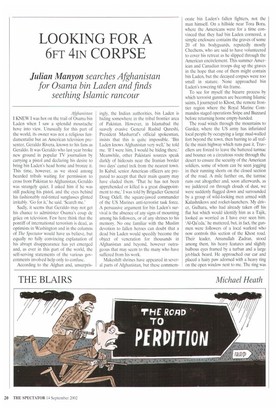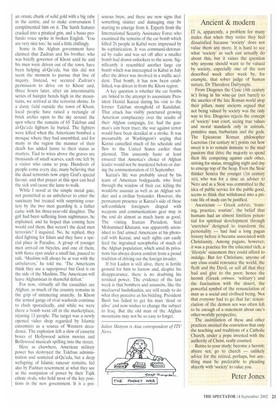LOOKING FOR A 6FT 41N CORPSE
Julian Manyon searches Afghanistan
for Osama bin Laden and finds seething Islamic rancour
Afghanistan I KNEW I was hot on the trail of Osama bin Laden when I saw a splendid moustache hove into view. Unusually for this part of the world, its owner was not a religious fundamentalist but an American television presenter, Gerald() Rivera, known to his fans as Geraldo. It was Gerald() who last year broke new ground in popular TV journalism by carrying a pistol and declaring his desire to bring bin Laden's head home and bronze it. This time, however, as we stood among bearded tribals waiting for permission to cross from Pakistan to Afghanistan. Gerald° was strangely quiet. I asked him if he was still packing his pistol, and the eyes behind his fashionably red-tinted sunglasses glinted irritably. 'Go for it,' he said. 'Search me.'
Sadly, it seems that Gerald° may not get his chance to administer Osama's coup de grace on television. Few here think that the pontiff of international terrorism is dead, as optimists in Washington and in the columns of The Spectator would have us believe, but equally no fully convincing explanation of his abrupt disappearance has yet emerged and, as ever in this part of the world, the self-serving statements of the various governments involved help only to confuse.
According to the Afghan and, unsurpris ingly, the Indian authorities, bin Laden is hiding somewhere in the tribal frontier area of Pakistan. However, in Islamabad the suavely evasive General Rashid Qureshi, President Musharrafs official spokesman, insists that this is quite impossible. 'Bin Laden knows Afghanistan very well,' he told me. If I were him, I would be hiding there.' Meanwhile, other Pakistani sources speak darkly of hideouts near the Iranian border two days' camel trek from the nearest town. In Kabul, senior American officers are prepared to accept that their main quarry may have eluded them. 'That he has not been apprehended or killed is a great disappointment to me,' I was told by Brigadier General Doug Odell, the square-jawed commander of the US Marines anti-terrorist task force. A persuasive argument for bin Laden's survival is the absence of any signs of mourning among his followers, or of any shrines to his memory. No one familiar with the Muslim devotion to fallen heroes can doubt that a dead bin Laden would speedily become the object of veneration for thousands in Afghanistan and beyond, however outrageous that may seem to the many who have suffered from his work.
Makeshift shrines have appeared in several parts of Afghanistan, but these commem orate bin Laden's fallen fighters, not the man himself. On a hillside near Tora Bora, where the Americans were for a time convinced that they had bin Laden cornered, a simple enclosure contains the graves of some 20 of his bodyguards, reputedly mostly Chechens, who are said to have volunteered to cover his retreat as he slipped through the American encirclement. This summer American and Canadian troops dug up the graves in the hope that one of them might contain bin Laden, but the decayed corpses were too small in stature. None approached bin Laden's towering bft 4in frame.
To see for myself the bizarre process by which terrorist gunmen are becoming Islamic saints, I journeyed to Khost, the remote frontier region where the Royal Marine Commandos staged operations Snipe and Buzzard before returning home empty-handed.
The road winds through the mountains to Gardez, where the US army has infuriated local people by occupying a large mud-walled fort beyond the town, then barring to all traffic the main highway which runs past it. Travellers are forced to leave the battered tarmac and bounce on a circuitous route through the desert to ensure the security of the American soldiers, some of whom can be seen jogging in their running shorts on the closed section of the road. A mile further on, the tarmac runs out altogether and, soon afterwards, as we juddered on through clouds of dust, we were suddenly flagged down and surrounded by a group of wild-looking men armed with Kalashnikovs and rocket-launchers. My driver, Gulhara, who had already taken off his flat hat which would identify him as a Tajik, looked as worried as I have ever seen him. 'Al-Oa'eda,' he muttered, but, in fact, the gunmen were followers of a local warlord who now controls this section of the Ithost road. Their leader, Amanullah Zadran, stood among them, his heavy features and slightly bulbous eyes framed by a turban and a large jet-black beard. He approached our car and placed a hairy paw adorned with a heavy ring on the open window next to me. The ring was an ornate chunk of solid gold with a big ruby in the centre, and to make conversation I complimented him on it. The harsh features cracked into a piratical grin, and a basso profundo voice spoke in broken English. 'You are very nice too,' he said a little chillingly.
Some in the Afghan government have claimed that Zadran and his brother, who was briefly governor of Khost until he and his men were driven out of the town, have been helping al-Qa'ecia, but this did not seem the moment to pursue that line of inquiry. Instead, we secured Zadran's permission to drive on to Khost and, three hours later, after an interminable series of hairpin bends high in the mountains, we arrived at the terrorist shrine. In a dusty field outside the town of Khost, local people have raised a rectangle of brick arches open to the sky around the spot where the remains of 65 Taleban and al-Qa'eda fighters lie buried. The fighters were killed when the Americans bombed a mosque where they had assembled, and for many in the region the manner of their death has added lustre to their status as martyrs. Tied to wires above the graves are thousands of small scarves, each one left by a visitor who came to pray. Hundreds of people come every day, many believing that the dead terrorists now enjoy God's special favour, and that prayer at this spot can heal the sick and cause the lame to walk.
While I stood at the simple metal gate, not permitted as an unbeliever to enter the sanctuary but treated with surprising courtesy by the two men guarding it, a father came with his three-year-old daughter. The girl had been suffering from nightmares, he explained, and he hoped that coming here would end them. But weren't the dead men terrorists? I inquired. No, he replied, they died fighting for Islam and they have a special place in Paradise. A group of younger men arrived on bicycles, and one of them, with fierce eyes under a small hat, paused to talk. 'Muslims will always be at war with the unbelievers,' he told me. 'The Americans think they are a superpower but God is on the side of the Muslims. The Americans will leave Afghanistan in shameful defeat.'
For now, virtually all the casualties are Afghan, as much of the country remains in the grip of simmering anarchy. In Khost the armed gangs of rival warlords continue to clash sporadically, and while we were there a bomb went off in the marketplace, injuring 13 people. The target was a newly opened video shop regarded by Islamic extremists as a source of Western decadence. The explosion left a slew of cassette boxes of Hollywood action movies and Bollywood musicals spilling into the street.
Here as elsewhere, American military power has destroyed the Taleban administration and scattered al-Qa'eda, but a deep wellspring of Islamic rancour remains, fed also by Pashtun resentment at what they see as the usurpation of power by their Tajik ethnic rivals, who hold most of the key positions in the new government. It is a poi
sonous brew, and there are now signs that something sinister and damaging may be starting to emerge from it. Experts from the International Security Assistance Force who examined the remains of the car bomb which killed 26 people in Kabul were impressed by its sophistication. It was command-detonated by radio and was set off after a smaller bomb had drawn onlookers to the scene. Significantly it resembled another large car bomb which was intercepted in Kabul in July after the driver was involved in a traffic accident. That bomb, it has now been established, was driven in from the Khost region.
A key question is whether the car bombs are linked to the attempt to assassinate President Hamid Karzai during his visit to the former Taleban stronghold of Kandahar. That attack has visibly punctured growing American complacency over the results of their Afghan campaign, for, had the gunman's aim been truer, the war against terror would have been derailed at a stroke. It was presumably at Washington's urging that Karzai cancelled much of his schedule and flew to the United States earlier than planned. This unseemly haste at least ensured that America's choice of Afghan leader would not be murdered before or during the commemoration of 11 September.
Karzai's life was probably saved by his team of American bodyguards, who fired through the window of their car, killing the would-be assassin as well as an Afghan soldier and a civilian bystander. However, the permanent presence at Karzai's side of these self-confident foreigners draped with weapons and communications gear may in the end do almost as much harm as good. The visiting Iranian President, Said Mohammed Khatami, was apparently astonished to find armed Americans at his photocall with Karzai; and such sights can easily feed the ingrained xenophobia of much of the Afghan population, which amid its privations has always drawn comfort from a proud tradition of driving out the foreign invader.
If bin Laden is still alive, there is fertile ground for him to furrow and, despite his disappearance, there is no doubting his residual power. The evidence of the last week is that bombers and assassins, like the mediaeval hashshashin, are still ready to do what they perceive as his bidding. President Bush has failed to get his man 'dead or alive. and now wishes to change the subject to Iraq. But the old man of the Afghan mountains may not be so easy to forget.
Julian Man von is Asia correspondent of ITV News.











































































 Previous page
Previous page